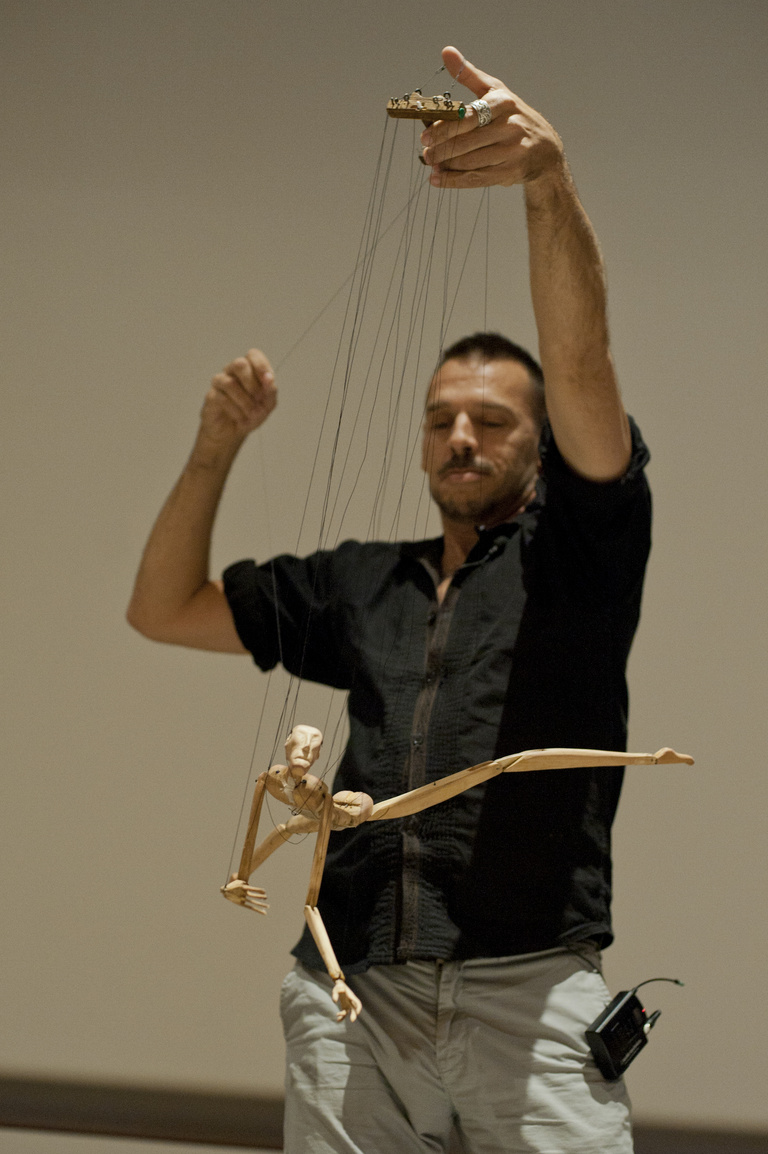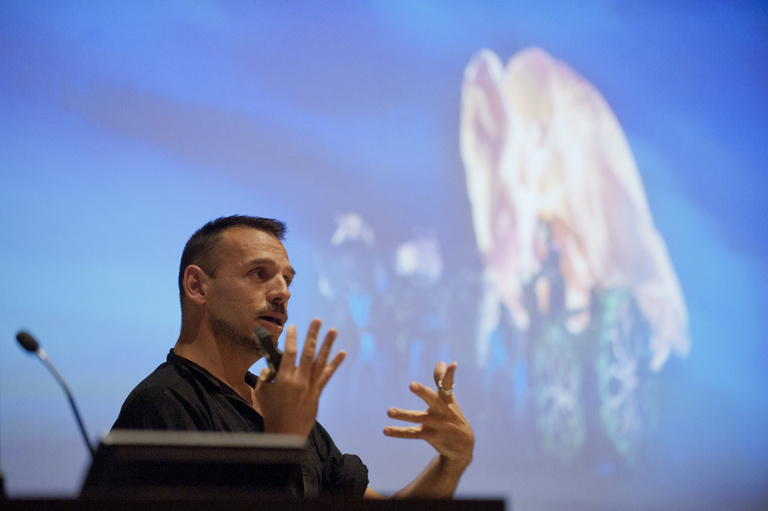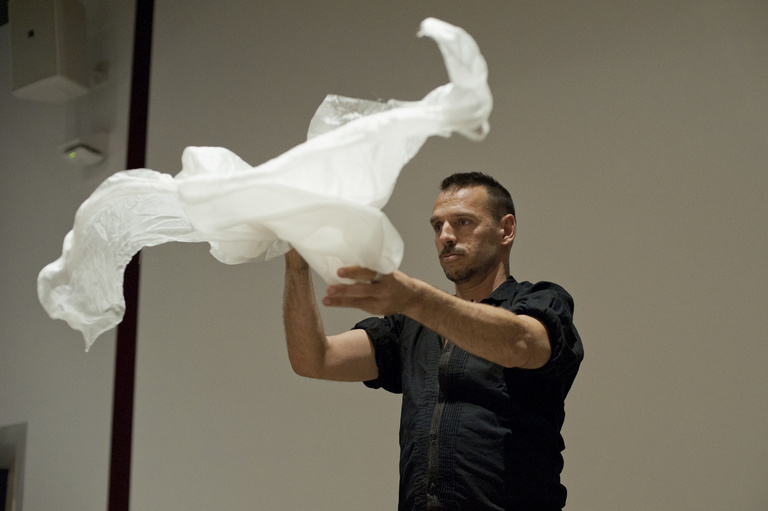
He moves like someone just awoken. Slowly he stretches, flexes, and rises up to perform a graceful arabesque. Then he floats up in the air—flying and swimming before descending back to earth. His posture and head movement subtly suggest fragility and despair. But then his head lifts, and he soars in circles around the man holding his strings, who for all intents has disappeared into the background.
Something enchanting, and a little unnerving, has taken place.
“When I made him move, I can feel you all respond to him,” said Basil Twist, acclaimed puppeteer and theater artist, after the applause died down at the second Creative Matters lecture on Sept. 29. “It’s just a piece of wood and strings. But there’s a craft that’s gone into it that provokes a response from you. You have a sensation, an impression, a feeling or a recognition of him being alive. It’s a mysterious phenomenon.”
This phenomenon, Twist said, forces us to start asking questions. Is the puppet alive? What does it mean that something is animate? The brief moment when we encounter the “life” of the slender wooden puppet, our minds and souls are “poked with that question mark,” said Twist.
He continued, “I think that puppetry—as much as it is considered an art for children—it’s actually a very profound and existential question that pours forward. It can be a little spooky for people. Sometimes uncomfortable.”
He hypothesized that children respond to puppetry because they haven’t been alive as long as adults, and they are closer to the freshness and wonder of living in the world, and thus are more in tune with the mysterious nature of it all.
“There is something about seeing a puppet come alive that connects us to our childhood spirit, and also that mysterious sense that is also in our ancient selves,” said Twist. “Puppetry is an ancient form, like music. This is an essential human thing—this idea of bringing something to life—that actually has sacred roots. That’s why I love it so much.”

He made the transition from the puppetry of Sesame Street to the puppetry of high art when he was accepted to the École Supérieure Nationale des Arts de la Marionnette, an international school of puppetry in Charleville-Mezieres, France. There he crafted his slender wooden puppet, which he still takes out and plays with to wind down, the way some people may sit back and plink on a guitar. It took him years to understand this puppet, an understanding formed by his exposure to an international mashup of puppetry training and technique.
“The experience of being in a French school, learning from a Brazilian master of an American technique and then supported by a Swedish master who taught me a Malaysian style to control this puppet is, in a nutshell, the privilege I had being in this world of puppetry and particularly this school,” he said.
It was at the École Supérieure Nationale des Arts de la Marionnette where Twist began to make connections that would lead him from representational puppetry to abstract puppetry. He was inspired by the history of an innovative French ballet troupe called the Ballets Russes which, at the dawn of the abstract movement in the visual arts, put on an abstract ballet that was billed as a ballet without dancers. Often in the arts, the various genres—visual, art, dance, music, theater—will move through similar movements: romanticism, impressionism, abstractionism. Twist was struck with how puppetry, as the art of making the inanimate come to life, had never fully entered the world of the abstract.
This ultimately inspired his first great success: Symphonie Fantastique.

The show premiered in April 1998 and ran for two years in New York City. It toured nationally and internationally for many years following. It led to other projects that allowed Twist to push the bounds of traditional puppetry and in 2015 his great talent was recognized with a MacArthur Foundation “Genius Grant,” which has further enabled him to advance his art.
In some ways there’s a “you had to be there” quality to Twist’s art. The allurement is something that doesn’t fully come through a picture, words or even a video. The enchantment is profoundly grounded in being present in the same space and time as the artist and his creation. For those who were at least still mildly confused by the notion of “abstract puppetry,” Twist offered a demonstration.
Twist again conjured life from the inanimate, this time with a small floor fan and a length of white silk that he packed tightly into his hands. He explained that the fan represented life force and the silk, the puppet.
As he loosened his grip, the silk began to flutter and rise, to come alive. After dancing with it a moment, Twist released the silk, and watched along with the audience as the fan’s breath went out of the fabric and it drifted to the ground and became still.
To watch the full lecture, please visit https://www.youtube.com/watch?v=EC7Vk4UrHGc&feature=youtu.be.
For a full listing of other events in the 2016-17 Creative Matters lecture series, please visit https://creativematters.research.uiowa.edu/.
The Creative Matters lecture series seeks to demonstrate that creativity is not only at the core of all research and discovery, but is also central to our human experience. The lineup of invited speakers includes artists, thinkers, builders, and doers who challenge conventional thinking about creativity, science, and artistic expression, borrowing from a range of influences and disciplines in their work.
The Office of the Vice President for Research and Economic Development provides resources and support to researchers and scholars at the University of Iowa and to businesses across Iowa with the goal of forging new frontiers of discovery and innovation and promoting a culture of creativity that benefits the campus, the state, and the world. More at http://research.uiowa.edu, and on Twitter: @DaretoDiscover.